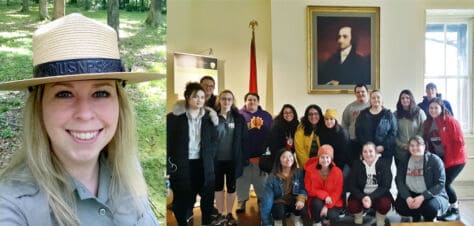WASHINGTON, PA (April 22, 2020) – Adjunct History instructor Hilary Miller ’08 had the perfect plan to bring to life her “Women in the Early American Republic” course. Partnering with the U.S. National Park Service, she connected her students with the Friendship Hill National Historic Site in nearby Point Marion, Fayette County, to create a thought-provoking exhibit showcasing the women affiliated with the site.
Her plan: launch the completed exhibit with some fanfare in late spring, timed to commemorate the centennial of the ratification of the U.S. Constitution’s 19th Amendment giving women the right to vote.
Then the Covid-19 pandemic struck, closing both the College campus and Friendship Hill.
While disappointed, Miller said the circumstances haven’t stopped her class from developing the content for this multi-faceted exhibit and completing this hands-on experiential learning opportunity.
“It definitely has been a challenge,” says Miller, a W&J alumna whose long-time professional affiliation with the National Park Service actually began with her own W&J internship at the Fort Necessity National Historic Site in Fayette County. “We’ve had to be more creative in developing the exhibit, but [students are] essentially working independently in teams to create a package.”
The historic site served as the home of Albert Gallatin, who became Secretary of the Treasury under Presidents Thomas Jefferson and James Madison. Gallatin is credited as the chief architect of the financing for the Louisiana Purchase, as well as for the National Road and the Lewis and Clark expedition.
Miller’s student project was designed to offer a close look at the 18th and 19th-century women who influenced Gallatin’s world at the time at Friendship Hill, including his second wife, Hannah, who was said to have been good friends with James Madison’s wife, Dolley.
“My students are focusing on four different women to anchor our exhibit, with four panels and many different themes,” Miller explained. “They’re split up into topical groups and dealing with those themes, and they’re writing text for the exhibit.”
Among the themes: late 18th century and early 19th century women living on the frontier; their political influence; labor, including domestic, indentured servitude and slavery; women’s education and fashion; and pop culture.
Fortunately, Miller said, she had been able to take her students to the site in February to study the environment, historical data, current exhibits, and other information.
The project has taken longer than anticipated, Miller conceded, given the communication challenges. “But the students have been responding and asking really fantastic questions” as they work through the design process. “And we’re connecting more, one-on-one.”
While Miller said the students won’t be able to see the project through to completion, she’s committed to it, no matter what. She plans to encourage the park to finish and install the exhibit once the historic site reopens, possibly even with student participation.
“I just want [the students] to get the glory and credit for the great work they’re doing,” she said.
This article is part of Thriving Together, a series of articles and videos showcasing the ways in which W&J community members are adapting to new situations and supporting each other during this unprecedented time. Read other articles in the series in the W&J News Section.
About Washington & Jefferson College
Washington & Jefferson College, located in Washington, Pa., is a selective liberal arts college founded in 1781. Committed to providing each of its students with the highest-quality undergraduate education available, W&J offers a traditional arts and sciences curriculum emphasizing interdisciplinary study and independent study work. For more information about W&J, visit washjeff.dev, or call 888-W-AND-JAY.



